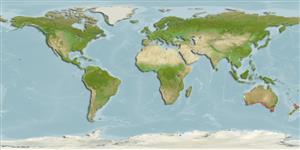>
Gobiiformes (Gobies) >
Gobiidae (Gobies) > Gobionellinae
Etymology: Nesogobius: Greek,nessa = island + Latin, gobius = gudgeon (Ref. 45335).
More on author: Castelnau.
Environment: milieu / climate zone / depth range / distribution range
ນິເວດວິທະຍາ
ສັດທະເລ ອາໄສຢູ່ໃກ້ໜ້າດິນໃຕ້ພື້ນທ້ອງນ້ຳ; ລະດັບຄວາມເລິກ ? - 20 m (Ref. 9002). Subtropical
Indo-West Pacific: widespread in the southern Australia, from Sydney, New South Wales to Perth, Western Australia, including Tasmania.
ຂະໜາດ / ນ້ຳໜັກ / Age
Maturity: Lm ? range ? - ? cm
Max length : 7.0 cm TL ຕົວຜູ້/ບໍ່ມີເພດ; (Ref. 9002); common length : 5.0 cm TL ຕົວຜູ້/ບໍ່ມີເພດ; (Ref. 9002)
Commonly found in seagrass areas, but also on rocky reefs to 20 m (Ref. 9002).
Life cycle and mating behavior
ການຈະເລີນເຕັມໄວ | ການສືບພັນ | ການວາງໄຂ່ | ໄຂ່ | ຄວາມດົກຂອງໄຂ່ປາ | ຕົວອ່ອນ
Kuiter, R.H., 1993. Coastal fishes of south-eastern Australia. University of Hawaii Press. Honolulu, Hawaii. 437 p. (Ref. 9002)
IUCN Red List Status (Ref. 130435: Version 2024-2)
Threat to humans
Harmless
Human uses
ເຄື່ອງມື
Special reports
Download XML
ແຫຼ່ງອີນເຕີເນັດ
Estimates based on models
Preferred temperature (Ref.
123201): 13.6 - 21.8, mean 17.2 °C (based on 338 cells).
Phylogenetic diversity index (Ref.
82804): PD
50 = 0.5625 [Uniqueness, from 0.5 = low to 2.0 = high].
Bayesian length-weight: a=0.01000 (0.00353 - 0.02836), b=3.08 (2.84 - 3.33), in cm total length, based on LWR estimates for this (Sub)family-body shape (Ref.
93245).
ຊັ້ນເຂດຮ້ອນ (Ref.
69278): 3.3 ±0.4 se; based on size and trophs of closest relatives
ຄວາມຢືດຢຸ່ນ (Ref.
120179): ສູງ, ປະຊາກອນຕຳ່ສຸດທີ່ໃຊ້ເວລາສອງໜ້ອຍກວ່າ 15 ເດືອນ (Preliminary K or Fecundity.).
Fishing Vulnerability (Ref.
59153): Low vulnerability (10 of 100).
Nutrients (Ref.
124155): Calcium = 353 [156, 872] mg/100g; Iron = 1.67 [0.86, 3.63] mg/100g; Protein = 17.8 [15.8, 19.5] %; Omega3 = 0.231 [0.094, 0.500] g/100g; Selenium = 17.4 [7.0, 41.0] μg/100g; VitaminA = 21.2 [5.2, 83.2] μg/100g; Zinc = 1.61 [1.01, 2.56] mg/100g (wet weight);
